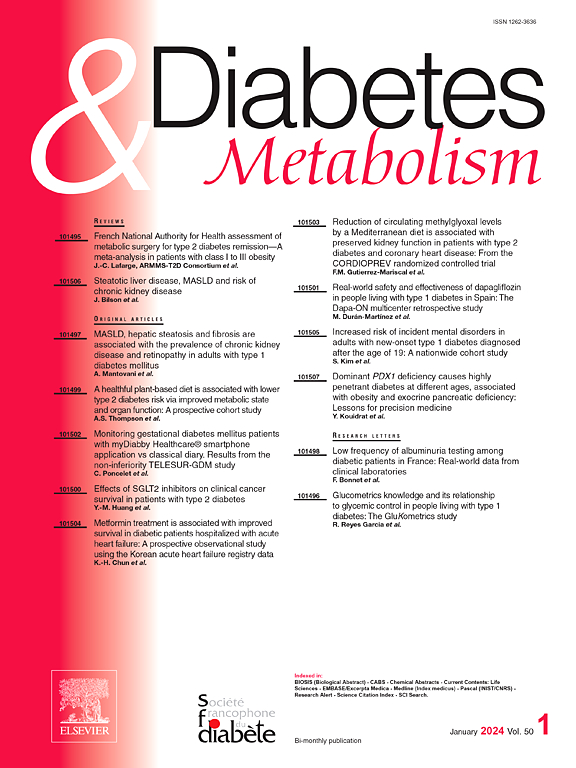Screening for autoimmune atrophic gastritis by serum gastrin measurement in subjects with type 1 diabetes
IF 4.7
2区 医学
Q1 ENDOCRINOLOGY & METABOLISM
引用次数: 0
Abstract
Introduction
Despite associated risk of anemia and gastric cancer, screening for autoimmune atrophic gastritis (AAG) is underperformed in subjects with type 1 diabetes mellitus (T1DM). We measured the predictive value of serum gastrin as a biomarker of gastric atrophy in subjects with T1DM and parietal cell autoantibodies (PCA).
Subjects and Methods
PCA measurements were retrospectively retrieved in 1,425 consecutive subjects with T1DM between 2014 and 2018. Screening for AAG was conducted in PCA+ subjects by measuring blood counts, serum ferritin, vitamin B12 and gastrin; and by performing gastroduodenal fibroscopy, with fundic biopsies for histology and Helicobacter pylori. The performance of blood biomarkers of gastric atrophy was analyzed in comparison with the histopathological gold standard.
Results
PCA were found in 185/1,425 subjects (13 %). PCA positivity was associated with female sex, older age, longer T1DM duration, and co-occurrence of anti-GAD and anti-thyroperoxydase autoantibodies. Of the 185 PCA+ subjects, 122 (66 %) participated in screening. AAG was found in 69/122 (57 %) subjects and Helicobacter pylori infection in 20/122 (16 %). Compared to PCA+ subjects without gastric atrophy, those with gastric atrophy had more frequently iron deficiency (65 % vs. 18 %, P < 0.0001), and/or vitamin B12 deficiency (57 % vs. 7 %, P < 0.0001); 44/69 (64 %) presented a pre-tumoral lesion and 6 % a tumor. Using a cut-off of 1.2-fold above the upper normal limit, serum gastrin concentration displayed 91 % sensitivity and 82 % specificity at predicting gastric atrophy.
Conclusion
In subjects with T1DM and PCA, serum gastrin is a reliable biomarker of gastric atrophy that can be used to select subjects requiring gastroduodenal fibroscopy.
1型糖尿病患者血清胃泌素测定对自身免疫性萎缩性胃炎的筛查
导论:尽管存在贫血和胃癌的相关风险,但自身免疫性萎缩性胃炎(AAG)在1型糖尿病(T1DM)患者中的筛查效果不佳。我们测量了血清胃泌素作为T1DM和壁细胞自身抗体(PCA)受试者胃萎缩的生物标志物的预测价值。对象和方法:回顾性检索2014年至2018年期间连续1425例T1DM患者的PCA测量值。通过测定血球计数、血清铁蛋白、维生素B12和胃泌素,对PCA+患者进行AAG筛查;并进行胃十二指肠纤维镜检查,并进行组织学和幽门螺杆菌的基础活检。与组织病理学金标准比较,分析胃萎缩血液生物标志物的表现。结果:1425例患者中有185例发现PCA(13%)。PCA阳性与女性、年龄较大、T1DM病程较长、抗广泛性焦虑症和抗甲状腺过氧酶自身抗体同时出现有关。185例PCA+患者中,122例(66%)参加了筛查。其中69/122例(57%)存在AAG, 20/122例(16%)存在幽门螺杆菌感染。与没有胃萎缩的PCA+受试者相比,胃萎缩患者更经常缺铁(65%对18%,P < 0.0001)和/或维生素B12缺乏症(57%对7%,P < 0.0001);44/69(64%)为瘤前病变,6%为肿瘤。使用高于正常上限1.2倍的截止值,血清胃泌素浓度在预测胃萎缩方面显示出91%的敏感性和82%的特异性。结论:在T1DM和PCA患者中,血清胃泌素是一种可靠的胃萎缩生物标志物,可用于选择需要胃十二指肠镜检查的受试者。
本文章由计算机程序翻译,如有差异,请以英文原文为准。
求助全文
约1分钟内获得全文
求助全文
来源期刊

Diabetes & metabolism
医学-内分泌学与代谢
CiteScore
12.00
自引率
4.20%
发文量
86
审稿时长
13 days
期刊介绍:
A high quality scientific journal with an international readership
Official publication of the SFD, Diabetes & Metabolism, publishes high-quality papers by leading teams, forming a close link between hospital and research units. Diabetes & Metabolism is published in English language and is indexed in all major databases with its impact factor constantly progressing.
Diabetes & Metabolism contains original articles, short reports and comprehensive reviews.
 求助内容:
求助内容: 应助结果提醒方式:
应助结果提醒方式:


